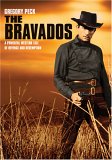| Reviews & Columns |
|
Reviews DVD TV on DVD Blu-ray 4K UHD International DVDs In Theaters Reviews by Studio Video Games Features Collector Series DVDs Easter Egg Database Interviews DVD Talk Radio Feature Articles Columns Anime Talk DVD Savant Horror DVDs The M.O.D. Squad Art House HD Talk Silent DVD
|
DVD Talk Forum |
|
|
| Resources |
|
DVD Price Search Customer Service #'s RCE Info Links |
|
Columns
|
|
|
Bravados, The
Jim Douglass (Peck), a tightlipped stranger, rides into a locked-down border town. Four men - outlaws Bill Zachary (Stephen Boyd) and Ed Taylor (Albert Salmi), half-breed Alfonso (Lee Van Cleef) and Mexican Indian Lujan (Henry Silva) - await execution the following morning for the murder of a bank teller during a botched robbery. Jim's appearance in the town isn't clear; he's clearly interested in the men's fate yet also claims not to know them. He does have a past relationship with one of the town's residents, Josefa Velarde (Joan Collins), who once loved him.
Spoilers
The condemned men eventually break out of jail, stabbing the local sheriff in the process, and while the town throws together a disorganized, ill-planned posse, Jim is careful and methodical, determined to hunt them down. He admits to being on their trail for the past six months, and isn't about to give up on them now. It eventually becomes clear Jim blames them for the rape and murder of his wife.
The Bravados quickly establishes the four outlaws, especially violent rapist Zachary as reprehensible criminal types, then spends much of the film questioning Jim's motives for joining the posse, and sets up the possibility that the four may not have raped and murdered Jim's wife after all. Like John Wayne's Ethan Edwards in The Searchers (1956), for Jim tracking these killers comes at the expense of all else; he even leaves his motherless child in a servant's care while for months he tracks men who in the end might not even be responsible for his wife's death.
Peck creates an intriguing air of mystery. He says hardly a word during the first few reels, and generally keeps his thoughts (if not his obvious obsession) to himself. (More spoilers) The picture's climatic scenes, where Jim has at last tracked down Lujan, probably really surprised 1958 audiences, as did the film's melancholy coda, with the town hailing Jim as a hero while he considers these same actions an unpardonable sin. The film was adapted from a novel by Frank O'Rourke, who also wrote the story that was adapted into The Professionals (1966). Philip Yordan is credited with the screenplay, but Yordan fronted for several blacklisted writers around this time, so it's possible someone else might be responsible for the carefully shaded script.
Leon Shamroy's cinematography (in CinemaScope) is quite interesting. Much of the film takes place at night, and Shamroy employs what appear to be unusually dense blue filters for these scenes. Blue filters are commonly used for day-for-night photography, but Shamroy takes this one step further. Night scenes are rendered nearly monochromatic, just as one sees little color in the dark, and the result is striking and effective.
One surprise certainly is the appearance of comedian Joe DeRita as the hangman. Immediately after this, DeRita would join Moe Howard and Larry Fine to become the last incarnation of The Three Stooges. Prior to The Bravados, in the late-1940s, DeRita had starred in a series of awful two-reel comedies at Columbia, and in both those shorts and later as "Curly-Joe" with the Stooges, DeRita was singularly unfunny. How he wound up in The Bravados is anyone's guess; he did nothing like it before or afterwards, yet it's a substantial supporting part. He's actually not bad, definitely better as a straight character actor than as a knockabout comedian. (His appearance, it should be noted, also marks the only time in screen history where, at one point, Gregory Peck is mistaken for one of the Three Stooges.)
Video & Audio
Filmed in CinemaScope, The Bravados is offered as a flipper disc, one side full frame panned-and-scanned, the other in a gorgeous 16:9 anamorphic transfer that retains the original theatrical aspect ratio of 2.35:1. The image is quite splendid, a bit grainy in the '50s CinemaScope manner, but with better, more vivid color than one usually expects from movies originally printed by De Luxe. The 4.0 Dolby Digital Surround is a good approximation of the 4-track magnetic stereo of the original, which especially enhances Lionel Newman's excellent score. French and Spanish tracks, both mono, are also available, as well as subtitles in English and Spanish.
Extra Features
The limited supplements include an interesting Theatrical Trailer, in 16:9 format complete with narration and text, with Peck directly addressing the camera and promising "something different." Two brief Fox Movietone News excerpts plug the picture, one with Hugh O'Brian demonstrating his quick draw. (He's not in The Bravados.)
Parting Thoughts
Thanks to DVD technology and the advent of widescreen televisions, a great many widescreen Westerns, which had always looked awful panned-and-scanned on TV, can at last be appreciated in a format that retains their original screen shape. Of course this doesn't help bad movies, but in cases like The Bravados, there are also a good many pleasant surprises.
Stuart Galbraith IV is a Los Angeles and Kyoto-based film historian whose work includes The Emperor and the Wolf -- The Lives and Films of Akira Kurosawa and Toshiro Mifune. His new book, Cinema Nippon will be published by Taschen in 2005.
|
| Popular Reviews |
| Sponsored Links |
|
|
| Sponsored Links |
|
|
| Release List | Reviews | Shop | Newsletter | Forum | DVD Giveaways | Blu-Ray | Advertise |
|
Copyright 2024 DVDTalk.com All Rights Reserved. Legal Info, Privacy Policy, Terms of Use,
Manage Preferences,
Your Privacy Choices | |||||||













